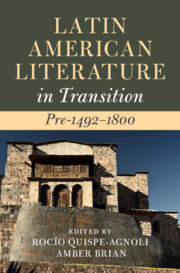Book contents
- Latin American Literature in Transition Pre-1492–1800
- Latin American Literature in Transition
- Latin American Literature in Transition Pre-1492–1800
- Copyright page
- Dedication
- Contents
- Figures
- Contributors
- Acknowledgments
- Introduction Dwelling in Transitions
- Part I Land, Space, Territory
- Part II Body
- Part III Belief Systems
- Chapter 9 The Flood Story in the Huarochirí Manuscript and Other Early Colonial Andean Texts
- Chapter 10 Idol or Martyr: Sacredness and Symbol in the Religiosity of the Indies
- Chapter 11 Creole Religiosity in Colonial Mexico: Devotional Cultures in Transition
- Chapter 12 The Empire Beyond Spanish America: Spanish Augustinians in the Pacific World, 1680–1724
- Chapter 13 Indigenous Peoples and Catholicism in Eighteenth-Century Mexico City
- Part IV Literacies
- Part V Languages
- Part VI Identities
- Index
- References
Chapter 9 - The Flood Story in the Huarochirí Manuscript and Other Early Colonial Andean Texts
from Part III - Belief Systems
Published online by Cambridge University Press: 25 November 2022
- Latin American Literature in Transition Pre-1492–1800
- Latin American Literature in Transition
- Latin American Literature in Transition Pre-1492–1800
- Copyright page
- Dedication
- Contents
- Figures
- Contributors
- Acknowledgments
- Introduction Dwelling in Transitions
- Part I Land, Space, Territory
- Part II Body
- Part III Belief Systems
- Chapter 9 The Flood Story in the Huarochirí Manuscript and Other Early Colonial Andean Texts
- Chapter 10 Idol or Martyr: Sacredness and Symbol in the Religiosity of the Indies
- Chapter 11 Creole Religiosity in Colonial Mexico: Devotional Cultures in Transition
- Chapter 12 The Empire Beyond Spanish America: Spanish Augustinians in the Pacific World, 1680–1724
- Chapter 13 Indigenous Peoples and Catholicism in Eighteenth-Century Mexico City
- Part IV Literacies
- Part V Languages
- Part VI Identities
- Index
- References
Summary
The Huarochirí Manuscript (c. 1608), writtenin the Andean province of the same name, near Lima, capital of the Viceroyalty of Peru, recounts the mythical origins of the gods (huacas) and heroes that were considered the ancestors of the communities that lived there. Based on accounts obtained from oral traditions, the manuscript was written in Quechua by an anonymous writer, and soon after Francisco de Ávila, the priest from Huarochirí, translated its first chapters to Spanish. Focusing on the Flood episode, one of the stories that combines biblical and Andean mythical elements, this chapter explores thematic transitions between Christian and indigenous belief systems in the 16th century.
Keywords
- Type
- Chapter
- Information
- Latin American Literature in Transition Pre-1492–1800 , pp. 137 - 150Publisher: Cambridge University PressPrint publication year: 2022

